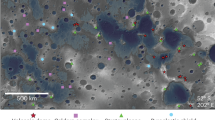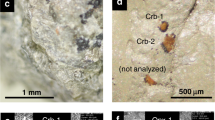Abstract
The surface of Mars is cold, dry, oxidizing, acidic and inhospitable to life. Similar conditions may have persisted for billions of years, suggesting that the best place to search for habitable environments is the subsurface1. One hint of habitable conditions at depth is the presence of atmospheric methane, which may have formed through hydrothermal processes in the crust2,3 in the presence of CO2. The observation of hydrated minerals excavated by some impact craters suggests that ancient hydrothermal systems may have existed in the subsurface4,5,6,7,8,9, but until now, none of those deposits has been linked to carbonate minerals and CO2-rich environments. Previous detections of carbonate minerals10 that could be linked to an ancient CO2-rich surface environment11 have been sparse. Here we show spectral evidence for carbonate- and phyllosilicate-bearing, layered and foliated bedrock exhumed from deep (about 6 km) within the martian crust by a meteor impact. The mineral assemblage, textural properties and geologic context of the deposits indicate that these rocks are probably ancient sediments that were metamorphosed during burial by younger volcanic materials from the nearby Syrtis Major volcano. We suggest that these buried layered carbonates might be only a small part of a much more extensive ancient carbonate sedimentary record that has been buried by volcanic resurfacing and impact ejecta. Our discovery may help explain the origin of other carbonates on Mars and indicates a high-priority site for future exobiological exploration.
This is a preview of subscription content, access via your institution
Access options
Subscribe to this journal
Receive 12 print issues and online access
$259.00 per year
only $21.58 per issue
Buy this article
- Purchase on Springer Link
- Instant access to full article PDF
Prices may be subject to local taxes which are calculated during checkout




Similar content being viewed by others
References
Des Marais, D., Jakosky, B. & Hynek, B. M. in The Martian Surface: Composition, Mineralogy, and Physical Properties (ed. Bell, J. F. III) (Cambridge Univ. Press, 2008).
Formisano, V., Atreya, S., Encrenaz, T., Ignatiev, N. & Giuranna, M. Detection of methane in the atmosphere of Mars. Science 306, 1758–1761 (2004).
Schulte, M., Blake, D., Hoehler, T. & McCollom, T. Serpentinization and its implications for life on the early Earth and Mars. Astrobiology 6, 364–376 (2006).
Fairén, A. G. et al. Noachian and more recent phyllosilicates in impact craters on Mars. Proc. Natl Acad. Sci. USA 107, 12095–12100 (2010).
Poulet, F. et al. Abundance of minerals in the phyllosilicate-rich units on Mars. Astron. Astrophys. 487, L41–L44 (2008).
Mustard, J. F. et al. Composition, morphology, and stratigraphy of noachian crust around the Isidis basin. J. Geophys. Res. 114, 1–18 (2009).
Ehlmann, B. L. et al. Identification of hydrated silicate minerals on Mars using MRO-CRISM: Geologic context near Nili Fossae and implications for aqueous alteration. J. Geophys. Res. 114, 1–33 (2009).
Murchie, S. L. et al. A synthesis of Martian aqueous mineralogy after 1 Mars year of observations from the Mars Reconnaissance Orbiter. J. Geophys. Res. 114, 1–30 (2009).
Carter, J., Poulet, F., Bibring, J-P. & Murchie, S. Detection of hydrated silicates in crustal outcrops in the northern plains of mars. Science 328, 1682–1686 (2010).
Ehlmann, B. L. et al. Orbital identification of carbonate-bearing rocks on Mars. Science 322, 1828–1832 (2008).
Kasting, J. F. CO2 condensation and the climate of Mars. Icarus 94, 1–13 (1991).
Bibring, J-P. et al. Global mineralogical and aqueous mars history derived from OMEGA/Mars express data. Science 312, 400–404 (2006).
Bishop, J. L. et al. Phyllosilicate diversity and past aqueous activity revealed at Mawrth Vallis, Mars. Science 321, 830–833 (2008).
Ehlmann, B. L., Mustard, J. F. & Murchie, S. L. Geologic setting of serpentine deposits on Mars. Geophys. Res. Lett. 37, 1–5 (2010).
Mustard, J. F. et al. Hydrated silicate minerals on Mars observed by the Mars reconnaissance orbiter CRISM instrument. Nature 454, 305–309 (2008).
Poulet, F. et al. Phyllosilicates on Mars and implications for early martian climate. Nature 438, 623–627 (2005).
Morris, R. V. et al. Identification of carbonate-rich outcrops on Mars by the spirit rover. Science 329, 421–424 (2010).
Pelkey, S. M. et al. CRISM multispectral summary products: Parameterizing mineral diversity on Mars from reflectance. J. Geophys. Res. 112, 1–18 (2007).
Milliken, R., Bish, D. L., Bristow, T. & Mustard, J. The case for mixed-layered clays on Mars. 41rst LPSC #2030 (2010).
Cintala, M. & Grieve, R. A. F. Scaling impact melting and crater dimensions: Implications for the lunar cratering record. Meteor. Planet. Sci. 33, 889–912 (1998).
Kenkmann, T., Jahn, A., Scherler, D. & Ivanov, B. A. Structure and formation of a central uplift: A case study at the Upheaval Dome impact crater, Utah. Geol. Soc. Am. Spec. Pap. 384, 85–115 (2005).
Pilkington, M. & Grieve, R. A. F. The geophysical signature of terrestrial impact craters. Rev. Geophys. 30, 161–181 (1992).
Schwenzer, S. P. & Kring, D. A. Impact-generated hydrothermal systems capable of forming phyllosilicates on Noachian Mars. Geology 37, 1091–1094 (2009).
Naumov, M. V. The principal features of impact-generated hydrothermal circulation systems: Mineralogical and geochemical evidence. Geofluids 5, 165–184 (2005).
Michalski, J., Poulet, F., Bibring, J. P. & Mangold, N. Analysis of phyllosilicate deposits in the Nili Fossae region of Mars: Comparison of TES and OMEGA data. Icarus 206, 269–289 (2010).
Michalski, J. R., Reynolds, S. J., Niles, P. B., Sharp, T. G. & Christensen, P. R. Alteration mineralogy in detachment zones: Insights from Swansea, Arizona. Geosphere 3, 184–198 (2007).
Mumma, M. J. et al. Strong release of methane on Mars in Northern Summer 2003. Science 323, 1041–1045 (2009).
Romanek, C. S. et al. Record of fluid–rock interactions on Mars from the meteorite ALH84001. Nature 372, 655–657 (1994).
Bandfield, J. L., Glotch, T. D. & Christensen, P. R. Spectroscopic identification of carbonate minerals in the Martian dust. Science 301, 1084–1087 (2003).
Boynton, W. V. et al. Evidence for calcium carbonate at the mars phoenix landing site. Science 325, 61–64 (2009).
Acknowledgements
Financial support for this work was provided by the Mars Data Analysis Program, grant #NNX09AN16G. The work was improved by discussions with E. N. Dobrea, J. Carter, F. Poulet, A. Baldridge, S. Wright, R. Milliken and A. Tripathy. This work benefited greatly from Mars data sets and JMARS software hosted by Arizona State University at: http://jmars.asu.edu and from the use of CRISM data analysis tools made available by the CRISM science team.
Author information
Authors and Affiliations
Contributions
J.R.M. wrote most of the manuscript and processed the remote sensing data; P.B.N. helped develop many ideas and wrote some sections of the manuscript.
Corresponding author
Ethics declarations
Competing interests
The authors declare no competing financial interests.
Supplementary information
Supplementary Information
Supplementary Information (PDF 897 kb)
Rights and permissions
About this article
Cite this article
Michalski, J., Niles, P. Deep crustal carbonate rocks exposed by meteor impact on Mars. Nature Geosci 3, 751–755 (2010). https://doi.org/10.1038/ngeo971
Received:
Accepted:
Published:
Issue Date:
DOI: https://doi.org/10.1038/ngeo971
This article is cited by
-
Unveiling microbial preservation under hyperacidic and oxidizing conditions in the Oligocene Rio Tinto deposit
Scientific Reports (2021)
-
Did Mars Possess a Dense Atmosphere During the First $\sim400$ Million Years?
Space Science Reviews (2021)
-
Inventory of CO2 available for terraforming Mars
Nature Astronomy (2018)
-
The Martian subsurface as a potential window into the origin of life
Nature Geoscience (2018)
-
Mars: a small terrestrial planet
The Astronomy and Astrophysics Review (2016)



